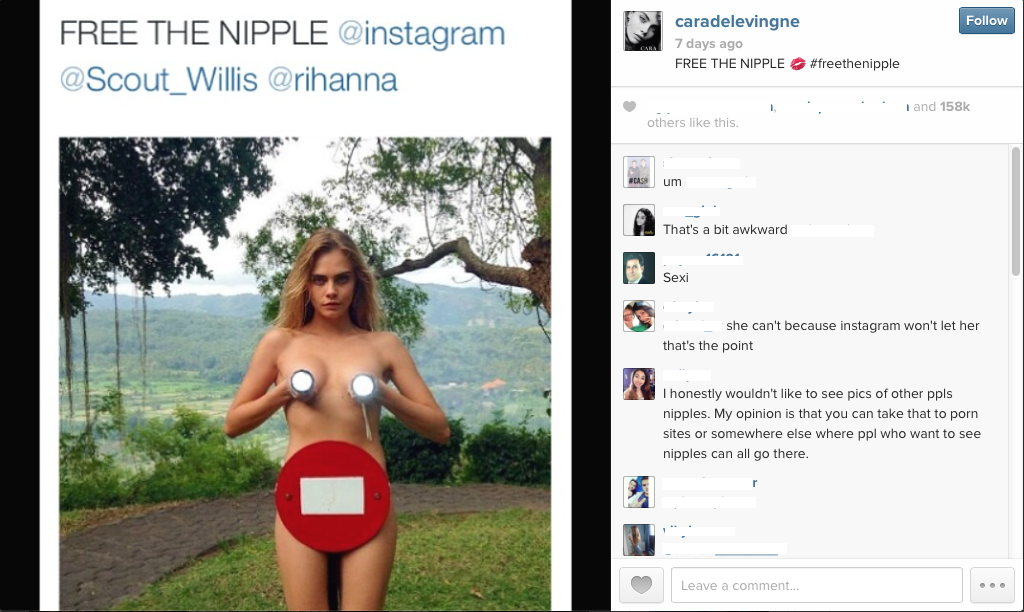Laws in place to cover women’s breasts are starting to slip thanks to a celebrity-driven campaign.
by Ashley Canino
Those of us who are less inclined to post topless photos to our social profiles may not have been aware that female nipples were unwelcome on our favorite sites and apps, regardless of context. That means that even a non-sexual context, such as a woman displaying the results of breast cancer surgery, is prohibited. Despite allowing memes pertaining to violence and rape, among other offensive content, the female nipple has been subject to swift removal from timelines and newsfeeds. When celebrity heavyweight Rihanna shut down her extremely popular Instagram account after the app deleted a couple of her “prohibited” photos, the issue came to the forefront. Since then, there has been a silent war waged against the female nipple and now the outspoken Free The Nipple campaign is fighting on its behalf.
The campaign, which shares a title with Lina Esco’s forthcoming political comedy, counts among its supporters Miley Cyrus, Scout and Rumer Willis, and other entertainers who have pushed the limits of picture-posting guidelines and appeared topless in public for the cause. As Hollywood makes Free The Nipple that much more sensational, the campaign has made some progress. Facebook recently changed its policy on user photos. Now, images related to mastectomies or depicting breastfeeding will not be removed for containing visible nipple.
Free The Nipple highlights how ingrained societal notions can mask gender inequality. There are currently no federal or state laws against men being shirtless–this has been legal since 1936. It was decades later when a few states began to make female toplessness legal. As freedom of exposed chests was born, there was a clear distinction between male and female rights and that distinction holds today: according to the Free The Nipple campaign website, it is still illegal in 35 states for a woman to be topless. The argument for the disparity is that male and female breasts are inherently different in that female breasts are more likely to incite a sexual response. By that logic, one foray through the Craigslist “gigs” section should be enough to support a federal law against flip-flops. Still, our notions of gender and propriety run deep. Even prominent campaign supporter Rumer Willis cannot help shying away from calling the campaign a feminist movement, claiming, “It doesn’t come down to being a female rights issue. It comes down to a human rights issue.” A campaign for gender equality is not really the place for fear of the “F” word.
Social media is not the final frontier for nipple freedom. Esco is fighting an NC-17 rating from the Motion Picture Association of America (MPAA), which regulates ratings for films. While the film does not contain a single sex scene, the Free The Nipple film has garnered a classification that bans children under 17 from seeing it in theaters, based on its depiction of bare breasts in non-sexual situations. That means the MPAA found exposed female breasts to be more prurient and potentially offensive than any of the scenes in Neighbors, the R-rated film in which Christopher Mintz-Plasse’s character wraps a certain part of his anatomy around a woman’s neck. In an attempt to undermine the MPAA without making any edits to the film, Free The Nipple organizers are gathering funding to promote and distribute the film independently. They have relied on celebrities, like Russell Simmons, who have thrown fundraisers on their behalf, and crowd-funding.
The fight for gender equality takes many forms. Maybe most women will not begin commuting topless, even if Free The Nipple is a success. And, perhaps, some of the celebrities are more motivated by greater exposure than the cause. The campaign’s value is in its high profile questioning of a repressive status quo, in a space that many have taken for granted.
Ashley Canino writes The Riveter‘s Pop Rivets column. You can follow her on Twitter @AshleyCanino.




